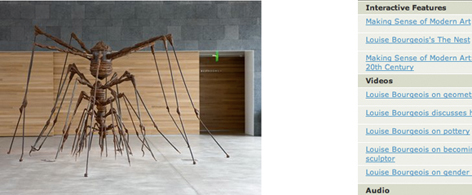Teaching & Learning Materials in Online Museums of Contemporary Art
Nicolás del Río
Graphic Designer / Part-time University Lecturer
ndelrio1@telefonica.net
Keywords: Online Museums, Online Learning, Contemporary Art, Educational Model, Higher Education
The current paper has two aims in mind. Firstly, it presents a summary of the current state of educational materials in online museums of contemporary art. Secondly, it suggests possible models for addressing higher education of contemporary art in an online environment.
Personal research has provided a somewhat bleak picture of online educational materials in contempo-rary art museum websites. Only 28% of them provide actual educational content. Conversely, 72% only offer information about educational activities on the premises. Within the 28%, (91 museums) 73 contain few and often unorganized materials: a pdf file, some students worksheets, teacher guides, etc., 15 mu-seums gather all their didactic proposals in educational micro-sites. Only 3 online museums clearly differ-entiate between learning online and learning at the museum and provide content accordingly. However, virtually all online educational content has been developed for students and teachers at primary and sec-ondary levels. For higher education users, most contemporary art museum websites simply provide texts and images: exhibition, brochure, catalog or panel texts, as well as articles, reviews and gallery labels. A smaller number of museums also provide valuable audiovisual resources which are sometimes integrated into interactive pieces or exhibitions, sometimes linked to images and sometimes grouped in multimedia sections. As a result, online museums of contemporary art run the risk of turning into digital repositories of disjointed materials. An online user gathering resources for higher education in those websites has to re-sort to picking and choosing content scattered among online collection databases, temporary exhibitions, online magazines, interactive materials and miscellaneous items from the learning section, if there is one.
As stated above, the second aim presents different approaches –developed by non contemporary art mu-seums and even commercial websites– that could work as models for higher education. The Virtual Mu-seum of Canada provides lesson plans (from Grade 1 to Higher Education) based on Learning Objects, a modular collection of resources with specific learning objectives. Museums such as the Metropolitan and the Rijksmuseum do not use a specifically didactic approach, but certain sections of their websites steer away from the database or gallery label approach offering an extensive contextualization and making it easier to locate related content. Commercial websites like Amazon, follow a similar approach but com-plemented with audience recommendations provided by users. Online educational repositories, while not created by museums, have close ties to them, like Fathom, in which museums, libraries and universities participate. Finally, apart from educational models developed by museums, the Web 2.0 opens a new door to a mixed educational model of museum and audience contributions.
Click for pdf download of the full paper 'Teaching & Learning Materials in Online Museums of Contemporary Art'
